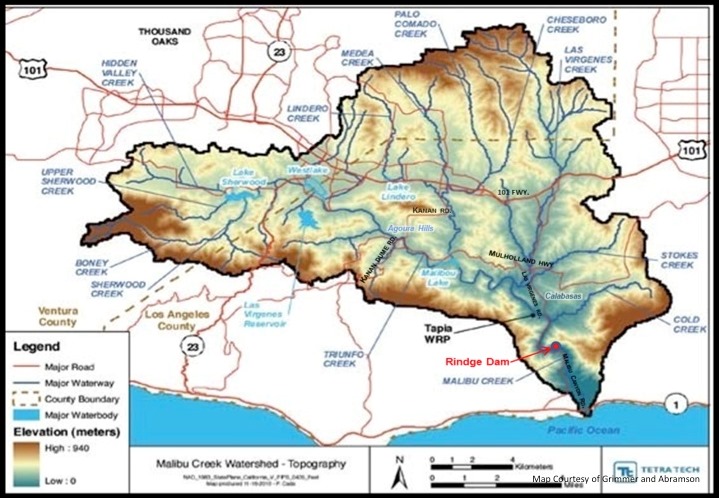What is Rindge Dam?
Rindge Dam is located on Malibu Creek, three-miles inland from Surfrider Beach in the Malibu area, Los Angeles County. It is located in the 109-square-mile Malibu Creek watershed which connects the communities including Ventura and Los Angeles counties, and the cities of Malibu, Thousand Oaks, West Lake Village, Agoura Hills, Calabasas and Hidden Hills. Elevations in the watershed range from over 3,100 feet at Sandstone Peak in the Santa Monica Mountains in Ventura County to sea level at the ocean’s edge.
The dam is an approximately 108-foot tall and 140-foot wide constant-radius arch dam that was built between 1924-26. It is considered eligible for the National Register of Historic Places due to its association with the Rindge and Adamson families of Malibu and that it is an example of privately funded large-scale infrastructure. Although originally an important source of stored water for agricultural use, it currently serves no agricultural purpose and scientific study indicates it adversely affects the environment and public safety.
Geologist Wayne Loel and civil engineer A. M. Strong designed the dam. It was built between1924-26 by Wayne Loel and engineer Harry Hawgood. The structure is made of concrete with recycled 30-foot long steel rails embedded into it for strength. The rails are remnants of the old Rindge railway. There are remains of the dam keeper’s cottage onsite.
Since the 1950s, Rindge Dam has been silted up and nonfunctional. It was decommissioned by the Public Utilities Commission in 1967. The dam currently provides no water supply and no energy services for the community.
Rindge Dam is the “keystone” barrier within Malibu Creek for endangered steelhead trout and other aquatic species. This means it is the first insurmountable barrier within the watershed for organisms moving upstream and is therefore the highest priority for removal.

Malibu Creek watershed (Courtesy of Abramson and Grimmer 2006)
